Rani Lakshmibai Biography: Queen Rani Lakshmi Bai of Jhansi, Uttar Pradesh. She played a significant role in the 1857 Indian revolt. She is still remembered as the most courageous queen, who fought alongside the British without dread. The commander of the forces that fought against the British was Rani Lakshmi Bai. She is one of India’s finest freedom fighters. Rani Lakshmi Bai commanded the troop of men and women fighting against the British army during the two-week revolt.
Rani Lakshmibai Biography
Early events in Rani Lakshmi Bai’s life
Rani Lakshmi Bai was born on November 19, 1828, in Varanasi, India. Her birth name was Manikarnika Tambe. Her father was Moropant Tambe and her mother was Bhagirathi Sapre. Moropant Tambe was a court Peshwa in Bithoor, also known as Rani Lakshmi bai ‘chhabili’. Her childhood was distinct from that of other females. She was homeschooled alongside the Peshwa sons. What made her childhood distinct was that she was educated as well as trained in martial arts, horsemanship, sword fighting, shooting, and fencing. She learned mallakhamba alongside her childhood companions Nana Sahib and Tantia Tope.
In May 1842, she wed Gangadhar Rao Newalkar, the maharaja of Jhansi. After marriage, Manikarnika’s name was altered to Lakshmi Bai. Gangadhar Rao and Rani Lakshmi bai had a son named Damodar Rao, but he passed away four months after his birth due to medical complications. They adopted and renamed their cousin Anand Rao Damodar Rao. Immediately after this, the Maharaja of Jhansi passed away, but before he did, he adopted his son legally and made Rani Lakshmi bai queen, granting her the authority to rule Jhansi for life.
The rebellion spearheaded by Rani Lakshmi Bai
The conflict between the British and Rani Lakshmi Bai began in 1857, when the British attempted to seize control of Jhansi. The uprising broke out in Meerut. After her spouse, the Maharaja of Jhansi, Gangadhar Rao, died, Rani Lakshmi bai was proclaimed the new ruler of Jhansi. Rani Lakshmi Bai was solely responsible for saving the city of Jhansi. She assumed command of the troops and devised a strategy to launch the conflict in Bundelkhand. As soon as the rebellion began, it spread like a forest fire, and many other rulers and proprietors joined it. After the revolt, she governed Jhansi without any intruders till 1858.
In 1858, Sir Hugh Rose, the commander of the central Indian Field force, declared that the entire city would be destroyed if the queen of Jhansi and her troops refused to surrender and depart the city. This had no effect on Rani Lakshmi Bai’s courage. She chose to oppose them and fight for their independence. The troops battled until their last breath, but were ultimately defeated by the adversaries.
She evacuated the fort with Damodar tied to her back while riding Badal, her horse. Few of her security escaped with her as well. With her fellow freedom advocates Tantia Tope, Nawab of Banda, and Rao Sahib, she was forced to flee to Gwalior after British troops attacked Kalpi. Nana Sahib was appointed Peshwa or sovereign in Gwalior. Lakshmi Bai warned everyone to remain vigilant for the British attack, but she was unable to persuade anyone. Lakshmi Bai’s prediction proved accurate when British troops attacked Gwalior and successfully captured Morar.
Rani Lakshmi Bai fought until the end and refused to give up. She was gravely wounded, yet she refused to surrender. She fought valiantly on the battlefield alone.
Rani Lakshmibai: Personal Life
Manikarnika was married to the Maharaja of Jhansi, Gangadhar Rao Newalkar, in May 1852, and was renamed Lakshmibai in accordance with tradition. Lakshmibai gave birth to her son Damodar Rao in 1851, but he passed away four months later. The couple later adopted Gangadhar Rao’s cousin, who was renamed, Damodar Rao. The adaptation procedure was conducted in the presence of a British officer. The officer was given a letter from the Maharaja with instructions to treat the adopted child with respect and to give Lakshmibai Jhansi for the remainder of her life.
However, in November 1853, following the demise of the Maharaja, the British East India Company, under the direction of Governor-General Lord Dalhousie, applied the Doctrine of Lapse. Damodar Rao’s claim to succession was denied because he was the adopted son of the Maharaja and Rani. In March 1854, Lakshmibai was given an annual pension of Rs. 60,000 and instructed to vacate the palace.
Jefferson Finis Davis Biography: Age, Birthday, Early Life, Career, Facts
Death
On June 17 at Kotah-ki-Serai, close to Gwalior’s Phool Bagh, British forces attacked Rani Lakshmibai’s Indian forces. The British Army executed five thousand Indian soldiers. Rani Lakshmibai was dismounted and injured. There are two perspectives on her demise: According to some accounts, she was haemorrhaging on the side of the road when the soldier fired upon recognising him. She was dispatched with his carbine. Alternatively, she was costumed as a cavalry commander and was severely wounded. Rani didn’t want the British to capture her corpse, so she instructed the hermit to burn it. Rani Lakshmibai died on June 18, 1858.

















